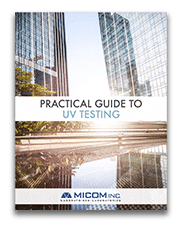Practical Guide to UV Testing (eBook) – Completely FREE
A Comprehensive Handbook Answering All Your Questions About UV Testing
Carefully crafted by Micom’s UV testing experts, this practical UV testing guide is a comprehensive resource designed to educate manufacturers on how to test their products for potential adverse effects of UV light. It provides valuable insights into the basics as well as the more complex principles of UV testing and accelerated aging, along with sound advice on how to prepare for a UV testing plan on your products.
Why should you download this guide?
As a manufacturer, it’s vital to guarantee the durability and reliability of your products when subjected to environmental stresses such as UV rays, and Micom recognizes this. Our guide is designed to help you better understand UV testing, the methods used, and what to consider when testing your products, whether they are made of one or many different materials. With this useful information, you’ll be able to reduce your risks, improve your product’s longevity, and enhance your brand’s reputation. Don’t miss this opportunity to improve your manufacturing process – download our eBook now!
What’s inside?
Within the 46 pages of this UV Testing Guide, you will gain profound knowledge on the following topics:
- What is accelerated aging?
- What are the basic rules of accelerated aging (temperature, dark cycles, water)?
- What is UV Exposure and Sunlight?
- What are solar exposure variations?
- What is the chemistry of the environment?
- Why is UV Testing important?
- How is UV Testing done in a laboratory?
- What is Carbon Arc?
- What is Xenon Arc?
- What is a time compression factor?
- What are the experimental parameters to specify when doing Xenon Arc testing?
- What is a fluorescent light exposure?
- The difference between ASTM G155 and ASTM G154 tests and when to use them?
- How to prepare a UV test plan?
- What are UV aging and quality control?
- When to retest a UV Test on a product?
- What is Xenon Arc UV Aging?
- Additional Test Methods, Practices and Specifications
- Fluorescent UV light exposure test methods
Get Your Free Copy of Our
UV Testing Guide

Simply fill out the form below to get your free PDF copy of our Practical Guide to UV Testing.
If you have any other questions about UV Testing, ASTM Testing or Accelerated Aging in general we invite you to contact us today. One of our testing professionals at Micom Laboratories will be happy to answer your questions about material testing. It will be our pleasure to talk to you and help you with your UV Testing requirements.

